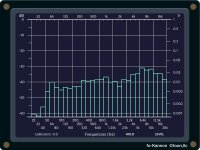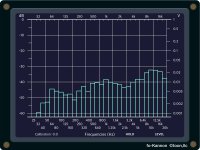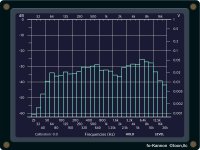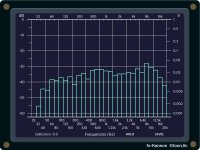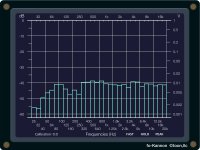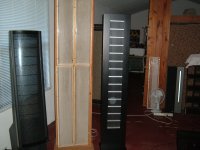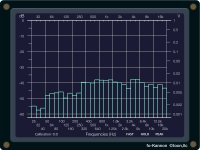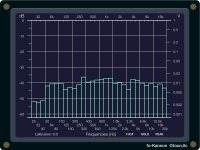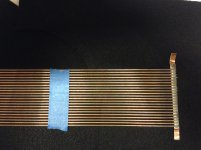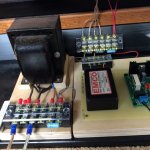Yes, all measurements were taken with the same set up. The mic was centered about halfway up the speaker, one foot away. Don't think any of the panels are wired out of phase, but will check just the same to make sure. Both left and right speakers showed the same dip, even though they're located in different parts of the room. If the measurements are taken farther away, say three feet, would that give you a better idea of what's occurring?
Bolserst, thanks for looking into this.
Bolserst, thanks for looking into this.
...The mic was centered about halfway up the speaker, one foot away.... If the measurements are taken farther away, say three feet, would that give you a better idea of what's occurring?
So, the measurement with the dip was taken 1ft from the panel as well?
Yes, measuring at further distances from the speaker will help better understand.
How far is your listening position from the speakers?
For starters, try 3ft and 6ft with mic centered as best you can on the middle panel.
- Measure just "Group 1" panels
- Measure all panels driven
Use 1 ohm series resistance for all measurements.
Yes, the dip measurement was also at one foot. I listen approximately 10 feet away, but sometimes at 12 feet.
Attachment 1: Center panels at 3 feet.
Attachment 2: Center Panels at 6 feet.
Attachment 3: All Panels at 3 feet.
Attachment 4: All Panels at 6 feet.
Attachment 1: Center panels at 3 feet.
Attachment 2: Center Panels at 6 feet.
Attachment 3: All Panels at 3 feet.
Attachment 4: All Panels at 6 feet.
Attachments
Somehow I have fried the Scott OPT in the speaker I've been doing most of my measurement testing. Had been experimenting with different resistor values from 100k down to 10k today for measurable and audible results. Decided to go back to original setup without resistors and started playing some Sinatra. Started out fine, but then the bass started to distort and then almost no sound at all. Eventually it boiled down to the trans. Tested the leads, and all of the ESL primary sides are dead shorted to each other. What the .... could I have done? I don't think I was ever going to restore the amp, but now definitely not. Unless in the unlikely event that I find an OPT on Ebay for a reasonable cost, or happen to stub my toe on one at a garage sale.
Have returned to the the Dyna OPT's but they sound kinda dull compared to the snap and dynamics of the Scotts; bass was better too. Surprised how much different they sound. I'm now a little concerned about screwing the Dyna's. Maybe I just shouldn't be fooling around with this stuff. Feeling a little dejected.
Have returned to the the Dyna OPT's but they sound kinda dull compared to the snap and dynamics of the Scotts; bass was better too. Surprised how much different they sound. I'm now a little concerned about screwing the Dyna's. Maybe I just shouldn't be fooling around with this stuff. Feeling a little dejected.
Oh dear , sorry to hear about the Scott OPT.Somehow I have fried the Scott OPT in the speaker I've been doing most of my measurement testing…. Have returned to the the Dyna OPT's but they sound kinda dull compared to the snap and dynamics of the Scotts; bass was better too. Surprised how much different they sound. I'm now a little concerned about screwing the Dyna's. Maybe I just shouldn't be fooling around with this stuff. Feeling a little dejected.
I hadn’t realized step-up was 90:1 with those. That would certainly generate much higher secondary voltages. The resistance of the primary windings will be close to a short…generally less than 1 ohm. I would think the more likely failure was secondary winding going open at the termination joint. Did you try measuring resistance of the ESL secondary sides to see if they are shorted or open? Should measure in the 100 – 500 ohm range.
What primary wires were you hooking up to? 4 ohm and ground like on the Dyna?
Also, what size power amp are you using to drive them?
Asking questions so I can maybe provide some input on why/how the Scott failed and what it might mean for the Dyna.
That sounds like a good plan. Did you notice any particular tipping point in the segmentation value?Had been experimenting with different resistor values from 100k down to 10k today for measurable and audible results. Decided to go back to original setup without resistors
I know with the Audiostatics that are also a 2 group segmented design, there was a definite resistor value that provided the most balanced response.
Apologies for not noticing your previous post with the 3ft and 6ft measurements. Will do some thinking this weekend and see if I can come up with a segmentation plan that might work better for your situation…perhaps moving to 3 groups instead of 2.
Hi Bolserst,
You've already gone way beyond being generous with your time, expertise, and patience. Jeepers, if it hadn't been for your help, these panels would have been out in the patio long ago electrocuting flies. I am and will be grateful for any help or suggestions you have, whenever you have the time.
The amp I am using puts out a good 130w pc. On the Scott OPT's, I used the two highest voltage measuring leads, which happened to be the 8 and 16 ohm taps. Mistake? As you mentioned, the ESL secondary leads are bad:
Good OPT Bad OPT
r-blu 144 ohms 116 ohms
r-br 158 ohms 67 ohms
blu-br opn 83 ohms
Didn't notice much a change from 10k-30k. Around 50k the 3k hump became a dip again. Became lazy and began to only pad the front stators. Mistake? Played some music with the 50k, but it still lacked some excitement.
Part of the problem is my aging ears, plus they have probably become accustomed to the sound without any segmented padding. Years ago a piano tuner advised me, "If you keep playing on an out of tuned piano, over time your ears will start to adjust to the out of tuneness, so that when you do hear a tuned piano, it will not sound right". I believe this applies to loudspeakers also.
Returned to the Khorns and they now sound awful-music coming from a whiskey barrel. Willing to tinker some more. Thanks again for all the help .
Bondsan
You've already gone way beyond being generous with your time, expertise, and patience. Jeepers, if it hadn't been for your help, these panels would have been out in the patio long ago electrocuting flies. I am and will be grateful for any help or suggestions you have, whenever you have the time.
The amp I am using puts out a good 130w pc. On the Scott OPT's, I used the two highest voltage measuring leads, which happened to be the 8 and 16 ohm taps. Mistake? As you mentioned, the ESL secondary leads are bad:
Good OPT Bad OPT
r-blu 144 ohms 116 ohms
r-br 158 ohms 67 ohms
blu-br opn 83 ohms
Didn't notice much a change from 10k-30k. Around 50k the 3k hump became a dip again. Became lazy and began to only pad the front stators. Mistake? Played some music with the 50k, but it still lacked some excitement.
Part of the problem is my aging ears, plus they have probably become accustomed to the sound without any segmented padding. Years ago a piano tuner advised me, "If you keep playing on an out of tuned piano, over time your ears will start to adjust to the out of tuneness, so that when you do hear a tuned piano, it will not sound right". I believe this applies to loudspeakers also.
Returned to the Khorns and they now sound awful-music coming from a whiskey barrel. Willing to tinker some more. Thanks again for all the help .
Bondsan
Yeah, you were probably pushing your luck a bit there.…The amp I am using puts out a good 130w pc. On the Scott OPT's, I used the two highest voltage measuring leads, which happened to be the 8 and 16 ohm taps. Mistake?
You may recall from your transformer thread the suggestion to keep power < 30W if using step-up options other than the 4 ohm input.
http://www.diyaudio.com/forums/plan...ct-transformer-bias-return-2.html#post4460343
If I am understanding your measurements correctly, you are saying the Good OPT measures open between the blue and brown wires? Should have been the sum of your other measurements (144 + 158) = 302; you might double-check it. Unfortunately, the measurements for the Bad OPT indicate you have some shorted winding layers in the secondary…not fixable like an open winding termination joint would have been.the ESL secondary leads are bad:
Good OPT Bad OPT
r-blu 144 ohms 116 ohms
r-br 158 ohms 67 ohms
blu-br opn 83 ohms
That certainly may be part of it. You might try sticking with the 50K segmentation resistors for a while and see if your perception changes.Part of the problem is my aging ears, plus they have probably become accustomed to the sound without any segmented padding….Returned to the Khorns and they now sound awful-music coming from a whiskey barrel.
I hear ya on the box/barrel speaker sound. Another indication that we get accustomed to different speaker deficiencies. After living with ESLs for 6 months, it was amazing how much enclosure noise I heard from box speakers that I had never noticed before.
Unfortunately, I do now recall your cautions in my CT thread....all the more foolish it makes me feel, especially after seeing what some people are asking for the old Scott amps on Ebay. It will make it even harder to find a parts chassis. But perhaps some of my foibles will have prevented others from the same mistakes, and possibly have provided some entertainment for any enthusiasts who are still reading this thread.
However the mistake for me was worth it to hear what a difference in sound the transformer can make. To my accustomed ears, the extra zip the Scotts provided the panels was just spectacular-really, really dynamic. The night before the demise of the OPT I was listening to an Erich Kunzel cd which included a recording of a few thunder bolts. Jeepers, the snap, crackle, kaboom, still brings a smile to my face as I write this. Except for the low end, I don't think the Klipsch's ever sounded better. Erich might have hastened the demise.
Soooooo....This brings me to wondering if there is a difference in sound between a high sensitive ESL using a low powered amp vs a low sensitive one using a high powered amp, with both having the same DB output level. I was considering connecting my old 40w tube amp to the Scotts, but now can't. But I am intrigued for possible future use with a higher ratio transformer.
However the mistake for me was worth it to hear what a difference in sound the transformer can make. To my accustomed ears, the extra zip the Scotts provided the panels was just spectacular-really, really dynamic. The night before the demise of the OPT I was listening to an Erich Kunzel cd which included a recording of a few thunder bolts. Jeepers, the snap, crackle, kaboom, still brings a smile to my face as I write this. Except for the low end, I don't think the Klipsch's ever sounded better. Erich might have hastened the demise.
Soooooo....This brings me to wondering if there is a difference in sound between a high sensitive ESL using a low powered amp vs a low sensitive one using a high powered amp, with both having the same DB output level. I was considering connecting my old 40w tube amp to the Scotts, but now can't. But I am intrigued for possible future use with a higher ratio transformer.
Have been listening with the 50k resistors for about a month and a half. My ears seem to have now become accustomed to the sound; a nice combination of smoothness and broad dispersion. Dispersion wise, I honestly can't tell any difference between the 100k and 50k, but the 50 sounds much more satisfying.
I think i'm just about done fiddling with the speakers, but before I summarize the build on the good, bad, and wish I would'ves, I hope a few more questions aren't minded:
As you can see in the graph below, the 50k seems to have evened out the higher frequencies nicely, but I now have a more pronounced dip in the 100 to 250hz region. I have moved some furniture around, so perhaps that's an influence? Phase cancellation, more equalization needed?
Is there a book you can recommend on loudspeaker design that a non engineer like me could understand, say 'Loudspeakers(especially ESL's) for Dummies'. Basically, I've been playing the piano by ear, but it wouldn't hurt to know what a few notes mean.
I think i'm just about done fiddling with the speakers, but before I summarize the build on the good, bad, and wish I would'ves, I hope a few more questions aren't minded:
As you can see in the graph below, the 50k seems to have evened out the higher frequencies nicely, but I now have a more pronounced dip in the 100 to 250hz region. I have moved some furniture around, so perhaps that's an influence? Phase cancellation, more equalization needed?
Is there a book you can recommend on loudspeaker design that a non engineer like me could understand, say 'Loudspeakers(especially ESL's) for Dummies'. Basically, I've been playing the piano by ear, but it wouldn't hurt to know what a few notes mean.
Attachments
One good thing...it well only take a min..to hear what the felt well do..So I just lay it in... but that's me...
I have these Audiosats..thay use silicone dots nothing on the back..only .segmented panels I have ever owned....this ESl type of sound is not for me.....have fun
...I like the look of the old Magnepan frame...
the dot in the pic come from the camera.....
I have these Audiosats..thay use silicone dots nothing on the back..only .segmented panels I have ever owned....this ESl type of sound is not for me.....have fun
...I like the look of the old Magnepan frame...
the dot in the pic come from the camera.....
Attachments
Last edited:
Moving furniture around certainly can modify the room response, but I think you are probably correct that the dip you are seeing is from un-equalized roll-off from dipole cancellation. Did you have your bass control adjusted up for this measurement? Post#23As you can see in the graph below, the 50k seems to have evened out the higher frequencies nicely, but I now have a more pronounced dip in the 100 to 250hz region. I have moved some furniture around, so perhaps that's an influence? Phase cancellation, more equalization needed?
If so, take another measurement with the bass control adjusted flat. Then we can design a simple shelving filter to flatten out the dip area.
See the last link in section 3) from Post#17
Unfortunately not too many books of that type around. Usually if they are for non-engineers, it is more of a cookbook with no real explanations...like the Sanders Book. Most other books are at the other extreme, often so technical it is difficult to follow if you haven’t been immersed in it for a while. One document geared toward ESLs that may fit the bill is available for download here:Is there a book you can recommend on loudspeaker design that a non engineer like me could understand, say 'Loudspeakers(especially ESL's) for Dummies'.
http://home.kpn.nl/verwa255/esl/ESL_English_2011.pdf
Interesting.....Having been gone for a while and returning to listen with 'fresh' ears, the speakers at first sounded just a bit brighter, but are now back to how I remembered them. Ears can sure be fickle sometimes.
The first attachment is the speaker's response with tone controls set to flat. The second is with the bass control all the way up. Did this for the fun of it. The low frequencies look better, but sound wise the boom effect begins slightly again....more flabby sounding. I prefer them with the bass about half way up, which should be around +3db @ 100hz. This was the setting in the post #50 measurement. All tests have been done with the mic centered about halfway up, three feet away.
The first attachment is the speaker's response with tone controls set to flat. The second is with the bass control all the way up. Did this for the fun of it. The low frequencies look better, but sound wise the boom effect begins slightly again....more flabby sounding. I prefer them with the bass about half way up, which should be around +3db @ 100hz. This was the setting in the post #50 measurement. All tests have been done with the mic centered about halfway up, three feet away.
Attachments
Ain't that the truth....Ears can sure be fickle sometimes.

Thanks for the measurements and setup details.The first attachment is the speaker's response with tone controls set to flat. The second is with the bass control all the way up...All tests have been done with the mic centered about halfway up, three feet away.
Can you can tell me the make and model of your power amplifier, or what its input impedance is?
With that info, I will see if there is a simple passive filter you can wire in between your pre and power amp that will help fill in that dip in the mid-bass.
Hi Bolserst,
There have been times(I'm sure you and others have experienced this too), that for no particular reason your sound system just sound better.....perceived more clarity, smoothness and just a much more enjoyable listening session. You think to yourself, what the heck has happened, has some sonic elf transformed my system to a new level of performance with 'metallic tractors'? But upon inspection, everything is as exactly as it was the night before. No change in the weather, either. Same bottle of beer. On these rare occasions, usually later in the evening, I'll spend hours listening to many of my old favorite and very familiar recordings, reluctant to turn things off and go to bed. Conversely, there are other times that I'll play one cd, shake my head and shut every thing down for the night. So basically, that leaves the sonic differences to my perceptions and fickle ears.
The amp that I am using is a Rotel RB-1070. There is a link below for the specs. I have a few other amps, one being an old Mac 240 that I used to power my Khorns. Before I fried one of the Scott OPT's, I had plan to try the Mac on the ESL's since the Scotts had double the turns ratio. Would you have an idea of what turns ratio would be needed to power the speakers to reasonable levels with around 50wpc? Also, if someday I am able to use the Mac, would another shelving circuit be necessary? As always, oodles of thanks for your genuine sonic improvements.
Bondsan
http://rotel.com/sites/default/files/product/infosheets/RB1070_InfoSheet_LR.pdf
There have been times(I'm sure you and others have experienced this too), that for no particular reason your sound system just sound better.....perceived more clarity, smoothness and just a much more enjoyable listening session. You think to yourself, what the heck has happened, has some sonic elf transformed my system to a new level of performance with 'metallic tractors'? But upon inspection, everything is as exactly as it was the night before. No change in the weather, either. Same bottle of beer. On these rare occasions, usually later in the evening, I'll spend hours listening to many of my old favorite and very familiar recordings, reluctant to turn things off and go to bed. Conversely, there are other times that I'll play one cd, shake my head and shut every thing down for the night. So basically, that leaves the sonic differences to my perceptions and fickle ears.
The amp that I am using is a Rotel RB-1070. There is a link below for the specs. I have a few other amps, one being an old Mac 240 that I used to power my Khorns. Before I fried one of the Scott OPT's, I had plan to try the Mac on the ESL's since the Scotts had double the turns ratio. Would you have an idea of what turns ratio would be needed to power the speakers to reasonable levels with around 50wpc? Also, if someday I am able to use the Mac, would another shelving circuit be necessary? As always, oodles of thanks for your genuine sonic improvements.
Bondsan
http://rotel.com/sites/default/files/product/infosheets/RB1070_InfoSheet_LR.pdf
Yup, it definitely happens. It is an every present frustration when trying to optimize a loudspeaker’s performance by ear. Once after tweaking the phase a bit in the crossover region of a Linkwitz Phoenix style dipole I suddenly noticed imaging performance like nothing I’d ever experienced before. Simply recorded jazz and classic discs just popped with an almost tangible 3D soundscape…album after album. I called a friend to come over to hear, and from the time I went to answer the door until I got back to the couch, the magic vanished…and never returned.There have been times…some sonic elf transformed my system to a new level of performance
Nice ampsWould you have an idea of what turns ratio would be needed to power the speakers to reasonable levels with around 50wpc? Also, if someday I am able to use the Mac, would another shelving circuit be necessary?
I’ll get back with you on transformer suggestions for use with the Mac. As far as the shelving network goes, the Mac has such a high input impedance, whatever we come up with for the Rotel can be used with the Mac by simply adding a single shunt resistor to make the input impedance match the Rotel.
. I called a friend to come over to hear, and from the time I went to answer the door until I got back to the couch, the magic vanished…and never returned.
Thanks for the chuckle. Like waking in the middle of a wonderful dream...try as you might to return to that beautiful lady, your brain has moved on to forgettable matters.
On to the build summary, starting with problems and issues I've run into:
-The biggest problem has been the bottom 7" horizontal panels; arcing and stator to diaphragm contact. They were actually an after thought as there wasn't quite enough space for a full 7" vertical addition to the existing bottom frame. To increase the surface area for possible bass augmentation, there was enough room to add the horizontal panels. I'm not sure what the causes were, but I think the longer 7" span was too much for the semi flexible ABS to handle, especially with the weight of the other three vertical panel assemblies pressing down on them resulting in the ABS bowing. I tried stiffening the plastic with aluminum bar strips and bracing the wood holding frame with extra wood blocks. Helped, but still occasional arcing. In another thread, Bolserst had mentioned he used FR4 for his latest panels. So I gave it a try and it worked. Much more rigid than ABS, a bit more difficult to work, and more expensive. If I were to rebuild all the panels with FR4, it would add about $100 to the total cost of the build, but think it would be worth it. Plus aesthetically, the horizontal panels just don't fit in right. Sometime in the future I'm going to try to shoe horn 3 vertical 7" panels. We'll see.
The second issue has been some mylar crinkling on a few of the diaphragm corners. Extra heat shrinking fixed most of it, but a few have been persistent. On one of the cells it was necessary to place a piece of Scotch tape on the mylar to insulate from the stator.
There have been other problems, most being stupid and/or ignorant mistakes. My biggest regret was forgetting the OPT wiring recommendations of Bolserst, and ruining one of the Scott trans. But after testing them and discovering their output, I got so excited that I forgot about his cautions on how I should have configured them.
-Things I would or might change:
Besides replacing the ABS with FR4, I'd probably start the progressive sized cells at 4" instead of 2 1/2" to end up with a two cell vertical 7" panels on the bottom, adding a little more weight to bass response.
While the aluminum cross bars look nice, I've read they add unwanted capacitance. I would replace the aluminum with 1/8" x 1/2" FR4. I've already experimented soldering stator wires to copper tape, so all I would have to do is glue the assembly to the FR4 cross bars. See attachment 1.
I might try stretching the mylar before it's glued to the panel frame to see if that helps the crinkling issue. And I might try Licron spray instead of graphite. I don't know. On small panels like these, graphite is actually very easy to apply(although messy), it's cheap, and has a known permanency.
-And now for the parts I'm pleased with:
As stated before , the speakers are surprisingly dynamic. They have that nice airy sound of ESL's, with excellent resolution, and 3D imaging. I was hoping the bass would go a little lower, but as they are, the low notes are satisfying for most of the music I listen to. The bass can go lower but at the expense of definition. I can understand now why the majority of ESL's are hybrid designs. However, there's a certain coherency to the music when all the sound comes from one single plane. Speaking of coherency, theses speakers sound somewhat different to tother stats I've heard. If you place you ear close(not too close, of course) to the top panels and move down to the bottom panels, you'll notice the sound at the top is bright and deepens as your ears move toward the bottom where most of the bass lies. Somewhat akin to traditional tweeter, midrange, woofer speakers. Not saying whether it is better or worse...just different.
I am happy with how the bias supply turned out. It makes for a simple, clean looking, adjustable HV unit for people like me who don't feel comfortable with building from scratch. I changed some of the terminals to ones with plastic covers for safety reasons . If someone were to try really hard, they could still get a good jolt, but at least there is no 120vac to pop the buttons off their shirt. I was also able to tuck the segmentation resistors neatly on the speaker terminals. See attachment 2.
With the 3"width diaphragms and segmentation that Bolserst designed, the speakers have a very wide, pleasing dispersion. For casual listening, my reading chair is about 2 feet left of the center of the two speakers, 12 feet back. My wife's chairs is to my right to where our heads are about 4 feet apart, yet both of us have a realistic very satisfying image, with no discernible loss of any detail. While my wife is not exactly doing cartwheels for joy with their looks, she doesn't mind them being in the living room. She definitely prefers them to the Khorns(which I've removed).
Of course I like the looks of the stats more than my wife does. The colors of the copper, aluminum, and black takes on a nice contrast. The copper will likely darken with age, so if that detracts from their looks, I'll cover them with grill cloth. I am sure many of you with ESL's have received similar comments from friends when they first see them...thinking they're some kind of space heaters or giant air filters. I never tire of firing the stats up and watching the reaction on their faces.
The build has been great fun and I've learned a lot. Thanks to all for taking the time to read through all of this. I hope all you wizards have enjoyed sharing your vast knowledge as much as I have appreciated learning it.
Of course a special thanks to Bolserst, for his absolutely amazing wealth of expertise and knowledge...on just about anything! Whether explaining complicated physics or electronic theory to the engineer oriented enthusiasts, to simpler explanations on which wires should be connected for a lay person like me. Even how to set up a table saw for ease of use.
With the greatest appreciation and sincerity,
Bondsan
Attachments
Nice amps
Yeah, i've had the Mac for around 40 years, with most of its time gathering sawdust in the garage. When I acquired the Khorns about five years ago, decided to resurrect it and replaced 90% of the caps and resistors. Sounded very good with the Klipsch's. It has a Line Out Octal socket with a choice of 70v, 125 ohms or 140v, 600 ohms, which is considerably more than the speaker taps. Can these be used to feed the Dyna OPT's, or am I asking for big trouble, as in destroying the amp, the Dyna's, and possibly the speakers?
I can sure empathize with your experience with perceived enhanced imagery after a minor tweak. I think this happens more often than people realize or admit to. However, the joy and excitement of that temporary illusion is well worth it in that moment of time.
Off topic, but how are many of you are able to highlight select quotes from posts? All the options I've tried quotes the whole post in brackets.
Thanks
Off topic, but how are many of you are able to highlight select quotes from posts? All the options I've tried quotes the whole post in brackets.
Unfortunately if I type in the format needed to quote, when I post it will be replaced be the quote format that I asked for so you can't see it. So, I attached a *.txt file that you can open and see how to quote portions of posts and perform other common formatting changes.
=======================================================================
The attached *.txt file was included in this message below, so you can see what it would look like when posted:
=======================================================================
To quote a portion of a post including link from post you are quoting:
Off topic, but how are many of you are able to highlight select quotes from posts?
To quote a portion of a post without including link:
text to be quoted
To bold a portion of a post:
text to be bolded
To underline a portion of a post:
text to be bolded
To italics a portion of a post:
text to be italics
To color a portion of a post red:
text to be red
To color a portion of a post blue:
text to be red
You can combine any of the above:
Fancy, Fancy.
Attachments
- Status
- This old topic is closed. If you want to reopen this topic, contact a moderator using the "Report Post" button.
- Home
- Loudspeakers
- Planars & Exotics
- Progressively Sized Wire Stators
